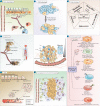The role of hypoxia in the tumor microenvironment and development of cancer stem cell: a novel approach to developing treatment
- PMID: 33472628
- PMCID: PMC7816485
- DOI: 10.1186/s12935-020-01719-5
The role of hypoxia in the tumor microenvironment and development of cancer stem cell: a novel approach to developing treatment
Abstract
Hypoxia is a common feature of solid tumors, and develops because of the rapid growth of the tumor that outstrips the oxygen supply, and impaired blood flow due to the formation of abnormal blood vessels supplying the tumor. It has been reported that tumor hypoxia can: activate angiogenesis, thereby enhancing invasiveness and risk of metastasis; increase survival of tumor, as well as suppress anti-tumor immunity and hamper the therapeutic response. Hypoxia mediates these effects by several potential mechanisms: altering gene expression, the activation of oncogenes, inactivation of suppressor genes, reducing genomic stability and clonal selection. We have reviewed the effects of hypoxia on tumor biology and the possible strategiesto manage the hypoxic tumor microenvironment (TME), highlighting the potential use of cancer stem cells in tumor treatment.
Keywords: Cancer progression; Cancer stem cells; Hypoxia; Tumor microenvironment; Tumor treatment.
Conflict of interest statement
The authors declare that they have no competing interests.
Figures

References
-
- Vaupel P, Kallinowski F, Okunieff P. Blood flow, oxygen and nutrient supply, and metabolic microenvironment of human tumors: a review. Cancer Res. 1989;49(23):6449–65. - PubMed
-
- Erler JT, Cawthorne CJ, Williams KJ, Koritzinsky M, Wouters BG, Wilson C, et al. Hypoxia-mediated down-regulation of Bid and Bax in tumors occurs via hypoxia-inducible factor 1-dependent and-independent mechanisms and contributes to drug resistance. Mol Cell Biol. 2004;24(7):2875–89. doi: 10.1128/MCB.24.7.2875-2889.2004. - DOI - PMC - PubMed
Publication types
LinkOut - more resources
Full Text Sources
Other Literature Sources

